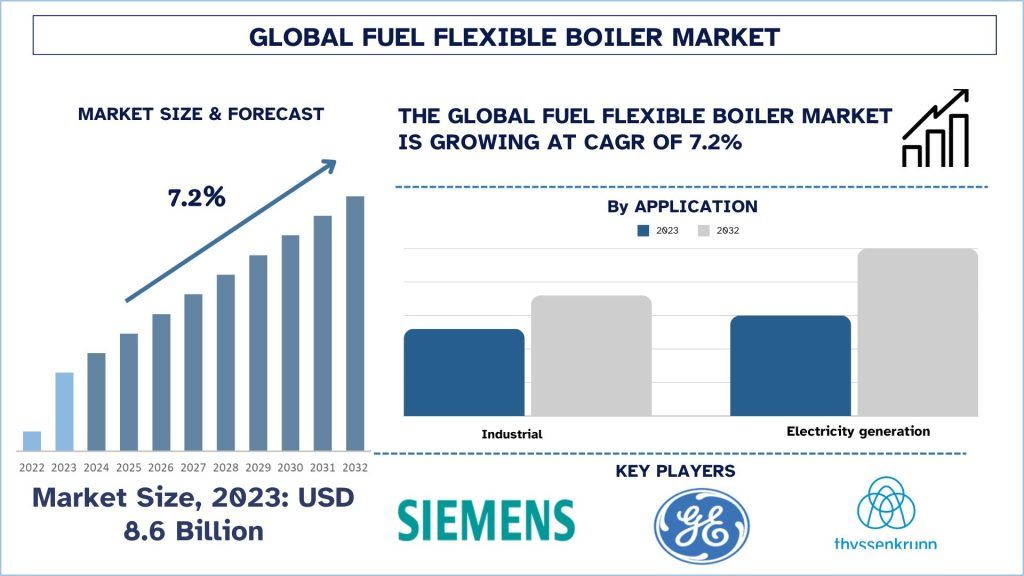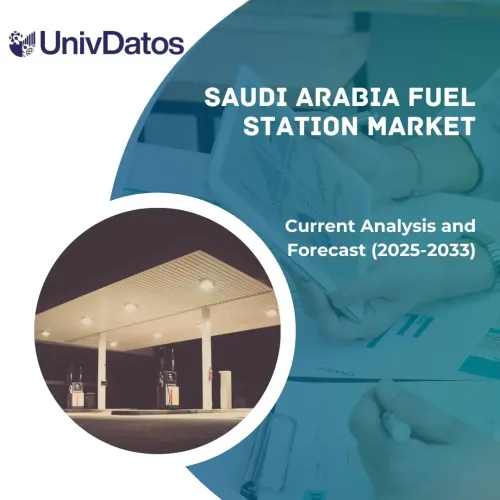- Trang chủ
- Về chúng tôi
- Ngành
- Dịch vụ
- Đọc
- Liên hệ với chúng tôi
Thị trường Lò hơi Đốt được Nhiều Loại Nhiên liệu: Phân tích Hiện tại và Dự báo (2024-2032)
Nhấn mạnh vào Loại (Đốt tầng sôi tuần hoàn (CFBC), Đốt tầng sôi khí quyển (AFBC), Lò hơi đốt đa nhiên liệu, Lò hơi dưới tới hạn); Ứng dụng (Công nghiệp, Phát điện); Khu vực/Quốc gia
Quy mô và Dự báo Thị trường Nồi hơi Đốt linh hoạt Nhiều loại Nhiên liệu
Giá trị Thị trường Nồi hơi Đốt linh hoạt Nhiều loại Nhiên liệu đạt 8,6 tỷ đô la Mỹ vào năm 2023 và dự kiến sẽ tăng trưởng với tốc độ CAGR mạnh mẽ khoảng 7,2% trong giai đoạn dự báo (2024-2032). Thị trường nồi hơi đốt linh hoạt nhiều loại nhiên liệu đang phát triển nhanh chóng do nhu cầu về các nguồn năng lượng hiệu quả và đa dạng ngày càng tăng. Nồi hơi đốt nhiều loại nhiên liệu, còn được gọi là nồi hơi đốt linh hoạt nhiều loại nhiên liệu, được sử dụng với nhiều loại nhiên liệu khác nhau như khí tự nhiên, dầu, sinh khối và chất thải. Tính linh hoạt này khiến chúng trở thành một lựa chọn hấp dẫn cho các ngành công nghiệp và cơ sở sản xuất điện đang cố gắng quản lý chi phí nhiên liệu hoặc tăng cường khả năng tự cung cấp năng lượng. Sự gia tăng liên tục trong tiêu thụ năng lượng trên toàn cầu do các yếu tố như công nghiệp hóa và đô thị hóa dự kiến sẽ thúc đẩy thị trường nồi hơi đốt linh hoạt nhiều loại nhiên liệu.
Phân tích Thị trường Nồi hơi Đốt linh hoạt Nhiều loại Nhiên liệu
Những nồi hơi này phù hợp để đảm bảo cung cấp đủ năng lượng vì chúng cho phép người dùng sử dụng nhiên liệu tùy thuộc vào tính sẵn có và chi phí của chúng. Hơn nữa, những đổi mới trong lĩnh vực nồi hơi đang làm tăng tính khả dụng và sử dụng của Nồi hơi Đốt linh hoạt Nhiều loại Nhiên liệu. Xu hướng tự động hóa và kiểm soát các nồi hơi này đảm bảo chuyển đổi nhiên liệu thích hợp và hiệu quả trong quá trình đốt cháy, và những yếu tố này mang lại cho nồi hơi một thị trường tốt hơn trong số những người dùng. Các chính phủ đang cố gắng khuyến khích và trợ cấp nồi hơi đốt linh hoạt nhiều loại nhiên liệu để sử dụng trong các ngành công nghiệp. Một số quốc gia châu Âu đã giới thiệu các gói hỗ trợ tài chính vào năm 2023 cho các ngành công nghiệp chuyển sang các công nghệ năng lượng sạch hơn, bao gồm cả nồi hơi đốt nhiều loại nhiên liệu.
Xu hướng Thị trường Nồi hơi Đốt linh hoạt Nhiều loại Nhiên liệu
Các Công nghệ Đốt tiên tiến: Trong năm tiếp theo, những tiến bộ trong các công nghệ đốt thế hệ tiếp theo vào năm 2023 cho phép sự linh hoạt về nhiên liệu mà nồi hơi có được. Một ví dụ về điều này là General Electric (GE) Power tiết lộ Hệ thống Đốt tầng sôi tuần hoàn (CFBC) thế hệ tiếp theo giúp tăng cường hiệu quả đốt nhiên liệu và cắt giảm khí thải. Điều này làm cho loại công nghệ này trở nên lý tưởng để đốt sinh khối, than đá cũng như chất thải, trong bất kỳ mục đích sử dụng công nghiệp nào.
Tích hợp Kỹ thuật số và Nồi hơi Thông minh: IoT và AI đã cách mạng hóa việc sử dụng nồi hơi thông qua việc tăng cường hệ thống của chúng. Siemens AG là một ví dụ về các công ty như vậy đã phát triển các giải pháp nồi hơi thông minh kết hợp các cảm biến IoT với các thuật toán AI để giúp xác định hiệu quả của nồi hơi và chất lượng nhiên liệu cũng như lên lịch kiểm tra bảo trì. Những nồi hơi thông minh này cải thiện tỷ lệ sản xuất, giảm thiểu thời gian tổn thất và cung cấp dữ liệu hiệu quả để đưa ra các quyết định được cải thiện.
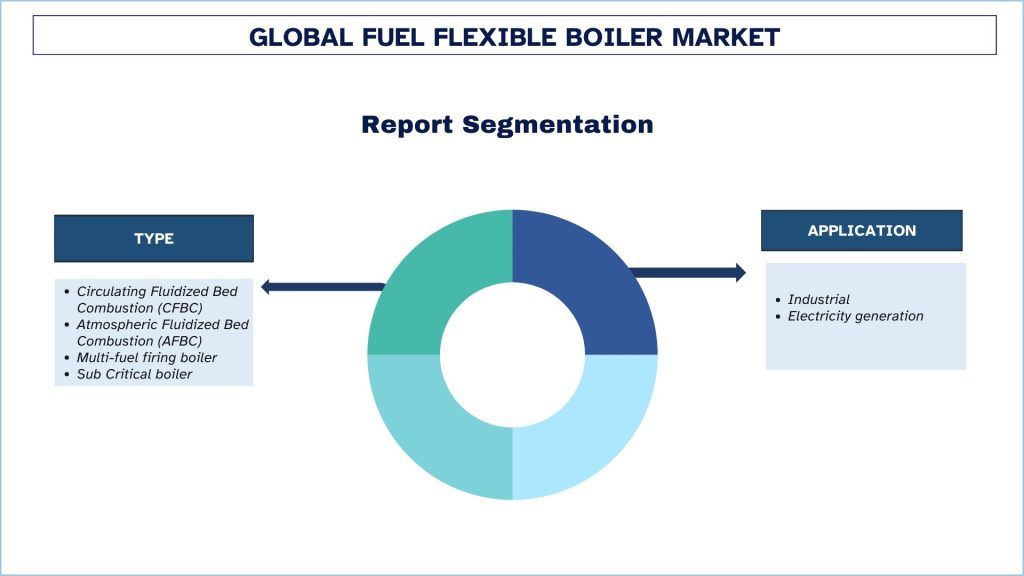
Châu Á Thái Bình Dương Dự kiến sẽ Tăng trưởng với CAGR Đáng kể Trong Giai đoạn Dự báo
Các quốc gia Châu Á - Thái Bình Dương như Trung Quốc, Ấn Độ và các quốc gia khác đang phát triển công nghiệp năng động hơn. Sự phát triển công nghiệp này thúc đẩy các yêu cầu về hiệu suất đối với các giải pháp năng lượng như nồi hơi đốt linh hoạt nhiều loại nhiên liệu. Hơn nữa, quá trình đô thị hóa ngày càng tăng trong khu vực đòi hỏi cơ sở hạ tầng phù hợp và các hệ thống sưởi ấm và phát điện hiệu quả mà nồi hơi đốt linh hoạt nhiều loại nhiên liệu có thể cung cấp. Ngoài ra, hầu hết các quốc gia Châu Á - Thái Bình Dương đều cố gắng cắt giảm sự phụ thuộc vào dầu mỏ nước ngoài bằng cách tìm kiếm các nguồn năng lượng khác nhau. Nồi hơi đốt linh hoạt nhiều loại nhiên liệu có thể hoạt động trên nhiều loại nhiên liệu bao gồm sinh khối và các dạng năng lượng tái tạo khác sẽ song hành với các biện pháp đa dạng hóa năng lượng này.
Tổng quan về Ngành Nồi hơi Đốt linh hoạt Nhiều loại Nhiên liệu
- Thị trường Nồi hơi Đốt linh hoạt Nhiều loại Nhiên liệu mang tính cạnh tranh và phân mảnh, với sự hiện diện của một số người chơi thị trường toàn cầu và quốc tế. Những người chơi chủ chốt đang áp dụng các chiến lược tăng trưởng khác nhau để tăng cường sự hiện diện trên thị trường của họ, chẳng hạn như quan hệ đối tác, thỏa thuận, hợp tác, ra mắt sản phẩm mới, mở rộng địa lý và sáp nhập và mua lại. Một số công ty lớn hoạt động trên thị trường là Siemens AG, ThyssenKrupp Industries India Pvt. Ltd, General Electric Co., Larsen and Toubro Ltd., Mitsubishi Heavy Industries Ltd., Parker Boiler Co., RAJDEEP BOILER PVT. LTD., Shanghai Electric Group Co. Ltd., Thermax Ltd. và Doosan Heavy Industries and Construction Co. Ltd.
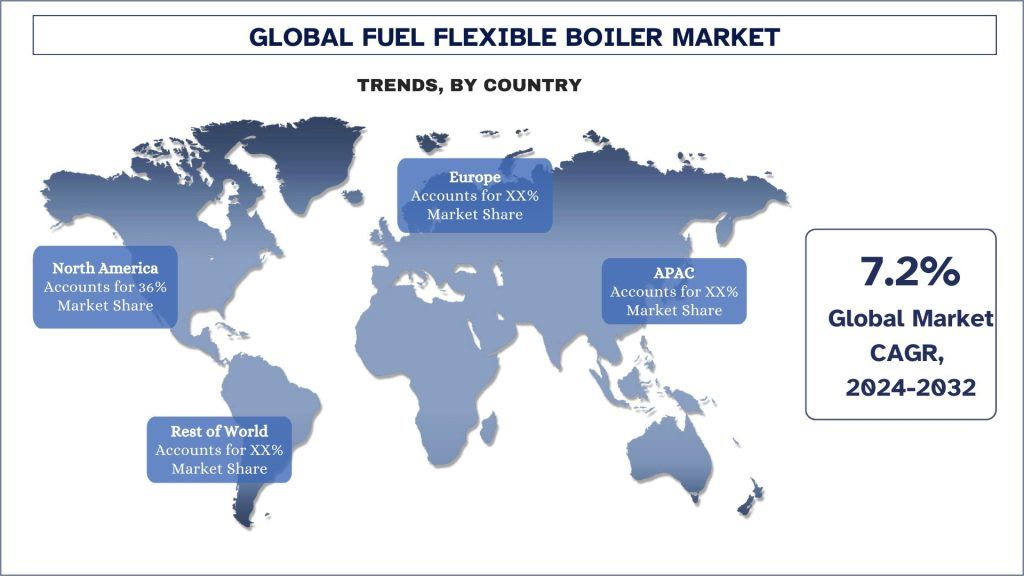
Tin tức Thị trường Nồi hơi Đốt linh hoạt Nhiều loại Nhiên liệu
Vào năm 2023, Siemens AG đã giới thiệu một thế hệ nồi hơi đốt linh hoạt nhiều loại nhiên liệu mới được thiết kế để phù hợp với nhiều nguồn nhiên liệu khác nhau, bao gồm sinh khối, khí tự nhiên và hydro.
Vào năm 2023, Doosan Heavy Industries đã tung ra một dòng nồi hơi hybrid mới có thể sử dụng cả nhiên liệu thông thường và nhiên liệu tái tạo.
Phạm vi Báo cáo Thị trường Nồi hơi Đốt linh hoạt Nhiều loại Nhiên liệu
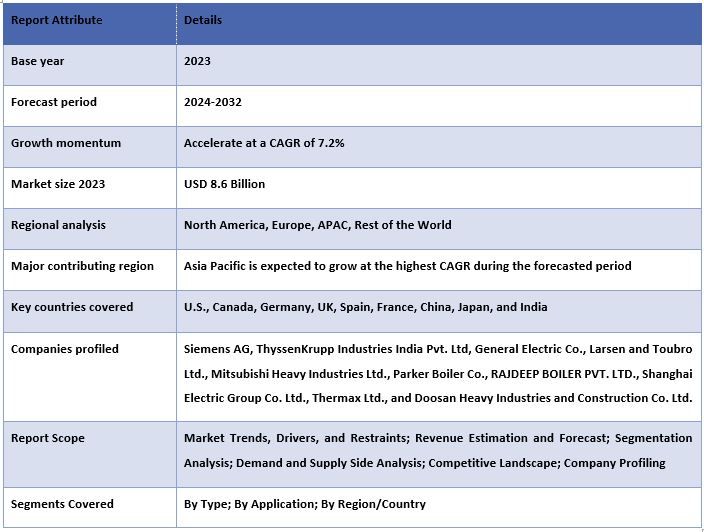
Lý do nên mua báo cáo này:
- Nghiên cứu bao gồm phân tích dự báo và định cỡ thị trường được xác thực bởi các chuyên gia hàng đầu trong ngành đã được xác thực.
- Báo cáo trình bày đánh giá nhanh về hiệu quả hoạt động tổng thể của ngành trong nháy mắt.
- Báo cáo bao gồm phân tích chuyên sâu về các đối thủ cạnh tranh nổi bật trong ngành với trọng tâm chính là tài chính kinh doanh chính, danh mục sản phẩm, chiến lược mở rộng và những phát triển gần đây.
- Xem xét chi tiết các động lực, hạn chế, xu hướng chính và cơ hội hiện có trong ngành.
- Nghiên cứu bao quát toàn diện thị trường trên các phân khúc khác nhau.
- Phân tích cấp khu vực chuyên sâu về ngành.
Tùy chọn Tùy chỉnh:
Thị trường Nồi hơi Đốt linh hoạt Nhiều loại Nhiên liệu toàn cầu có thể được tùy chỉnh thêm theo yêu cầu hoặc bất kỳ phân khúc thị trường nào khác. Bên cạnh đó, UMI hiểu rằng bạn có thể có nhu cầu kinh doanh riêng của mình, do đó, hãy thoải mái liên hệ với chúng tôi để nhận được một báo cáo hoàn toàn phù hợp với yêu cầu của bạn.
Mục lục
Phương Pháp Nghiên Cứu Phân Tích Thị Trường Lò Hơi Linh Hoạt Nhiên Liệu (2024-2032)
Phân tích thị trường lịch sử, ước tính thị trường hiện tại và dự báo thị trường tương lai của thị trường Lò Hơi Linh Hoạt Nhiên Liệu toàn cầu là ba bước chính được thực hiện để tạo và phân tích việc ứng dụng Lò Hơi Linh Hoạt Nhiên Liệu ở các khu vực chính trên toàn cầu. Nghiên cứu thứ cấp chuyên sâu đã được thực hiện để thu thập các số liệu thị trường lịch sử và ước tính quy mô thị trường hiện tại. Thứ hai, để xác thực những hiểu biết này, nhiều phát hiện và giả định đã được xem xét. Hơn nữa, các cuộc phỏng vấn sơ cấp chuyên sâu cũng đã được thực hiện, với các chuyên gia trong ngành trên toàn chuỗi giá trị của thị trường Lò Hơi Linh Hoạt Nhiên Liệu toàn cầu. Sau khi giả định và xác thực các số liệu thị trường thông qua các cuộc phỏng vấn sơ cấp, chúng tôi đã sử dụng phương pháp tiếp cận từ trên xuống/từ dưới lên để dự báo quy mô thị trường hoàn chỉnh. Sau đó, các phương pháp phân tích dữ liệu và tam giác dữ liệu đã được áp dụng để ước tính và phân tích quy mô thị trường của các phân khúc và phân khúc con của ngành có liên quan. Phương pháp luận chi tiết được giải thích dưới đây:
Phân Tích Quy Mô Thị Trường Lịch Sử
Bước 1: Nghiên Cứu Sâu Các Nguồn Thứ Cấp:
Một nghiên cứu thứ cấp chi tiết đã được thực hiện để có được quy mô thị trường lịch sử của thị trường Lò Hơi Linh Hoạt Nhiên Liệu thông qua các nguồn nội bộ của công ty như báo cáo thường niên & báo cáo tài chính, các bài thuyết trình về hiệu suất, thông cáo báo chí, v.v. và các nguồn bên ngoài bao gồm tạp chí, tin tức & bài viết, ấn phẩm của chính phủ, ấn phẩm của đối thủ cạnh tranh, báo cáo ngành, cơ sở dữ liệu của bên thứ ba và các ấn phẩm đáng tin cậy khác.
Bước 2: Phân Khúc Thị Trường:
Sau khi có được quy mô thị trường lịch sử của thị trường Lò Hơi Linh Hoạt Nhiên Liệu, chúng tôi đã tiến hành phân tích thứ cấp chi tiết để thu thập thông tin chi tiết và chia sẻ thị trường lịch sử cho các phân khúc & phân khúc con khác nhau cho các khu vực chính. Các phân khúc chính được bao gồm trong báo cáo như loại, ứng dụng và khu vực. Các phân tích cấp quốc gia sâu hơn đã được tiến hành để đánh giá việc áp dụng chung các mô hình thử nghiệm ở khu vực đó.
Bước 3: Phân Tích Yếu Tố:
Sau khi có được quy mô thị trường lịch sử của các phân khúc và phân khúc con khác nhau, chúng tôi đã tiến hành phân tích yếu tố chi tiết để ước tính quy mô thị trường hiện tại của thị trường Lò Hơi Linh Hoạt Nhiên Liệu. Hơn nữa, chúng tôi đã tiến hành phân tích yếu tố bằng cách sử dụng các biến phụ thuộc và độc lập như loại và ứng dụng của thị trường Lò Hơi Linh Hoạt Nhiên Liệu. Một phân tích kỹ lưỡng đã được tiến hành về các kịch bản cung và cầu xem xét các quan hệ đối tác hàng đầu, sáp nhập và mua lại, mở rộng kinh doanh và ra mắt sản phẩm trong lĩnh vực thị trường Lò Hơi Linh Hoạt Nhiên Liệu trên toàn cầu.
Ước Tính & Dự Báo Quy Mô Thị Trường Hiện Tại
Định Cỡ Thị Trường Hiện Tại: Dựa trên những hiểu biết sâu sắc có thể hành động từ 3 bước trên, chúng tôi đã xác định được quy mô thị trường hiện tại, những người chơi chính trong thị trường Lò Hơi Linh Hoạt Nhiên Liệu toàn cầu và thị phần của các phân khúc. Tất cả các phần trăm chia sẻ cần thiết và phân tích thị trường đã được xác định bằng cách sử dụng phương pháp thứ cấp đã đề cập ở trên và được xác minh thông qua các cuộc phỏng vấn sơ cấp.
Ước Tính & Dự Báo: Để ước tính và dự báo thị trường, trọng số đã được gán cho các yếu tố khác nhau bao gồm các động lực & xu hướng, hạn chế và cơ hội có sẵn cho các bên liên quan. Sau khi phân tích các yếu tố này, các kỹ thuật dự báo có liên quan, tức là phương pháp tiếp cận từ trên xuống/từ dưới lên đã được áp dụng để đưa ra dự báo thị trường năm 2032 cho các phân khúc và phân khúc con khác nhau trên các thị trường chính trên toàn cầu. Phương pháp nghiên cứu được áp dụng để ước tính quy mô thị trường bao gồm:
- Quy mô thị trường của ngành, về doanh thu (USD) và tỷ lệ chấp nhận của thị trường Lò Hơi Linh Hoạt Nhiên Liệu trên các thị trường chính trong nước
- Tất cả các phần trăm chia sẻ, phân tách và phân tích các phân khúc và phân khúc con của thị trường
- Những người chơi chính trong thị trường Lò Hơi Linh Hoạt Nhiên Liệu toàn cầu liên quan đến các sản phẩm được cung cấp. Ngoài ra, các chiến lược tăng trưởng được các công ty này áp dụng để cạnh tranh trên thị trường đang phát triển nhanh chóng.
Xác Thực Quy Mô và Thị Phần Thị Trường
Nghiên Cứu Sơ Cấp: Các cuộc phỏng vấn chuyên sâu đã được thực hiện với những Người có ý kiến chủ chốt (KOL) bao gồm các Giám đốc điều hành cấp cao (CXO/VP, Trưởng phòng kinh doanh, Trưởng phòng tiếp thị, Trưởng phòng vận hành, Trưởng phòng khu vực, Trưởng phòng quốc gia, v.v.) trên khắp các khu vực chính. Các phát hiện nghiên cứu sơ cấp sau đó đã được tóm tắt và phân tích thống kê đã được thực hiện để chứng minh giả thuyết đã nêu. Thông tin đầu vào từ nghiên cứu sơ cấp đã được hợp nhất với các phát hiện thứ cấp, do đó biến thông tin thành những hiểu biết sâu sắc có thể hành động.
Phân Chia Người Tham Gia Sơ Cấp ở Các Khu Vực Khác Nhau
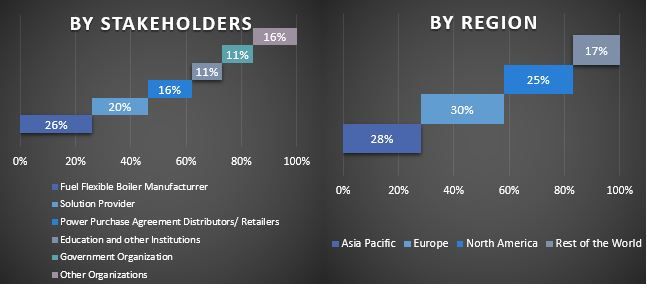
Kỹ Thuật Thị Trường
Kỹ thuật tam giác dữ liệu đã được sử dụng để hoàn thành ước tính thị trường tổng thể và đưa ra các số liệu thống kê chính xác cho từng phân khúc và phân khúc con của thị trường Lò Hơi Linh Hoạt Nhiên Liệu toàn cầu. Dữ liệu được chia thành nhiều phân khúc & phân khúc con sau khi nghiên cứu các thông số và xu hướng khác nhau trong các lĩnh vực loại và ứng dụng trong thị trường Lò Hơi Linh Hoạt Nhiên Liệu toàn cầu.
Mục tiêu chính của Nghiên cứu Thị trường Lò hơi Linh hoạt Nhiên liệu Toàn cầu
Các xu hướng thị trường hiện tại & tương lai của thị trường Lò Hơi Linh Hoạt Nhiên Liệu toàn cầu đã được xác định rõ trong nghiên cứu. Các nhà đầu tư có thể thu được những hiểu biết chiến lược để dựa vào quyết định của họ cho các khoản đầu tư dựa trên phân tích định tính và định lượng được thực hiện trong nghiên cứu. Các xu hướng thị trường hiện tại và tương lai đã xác định mức độ hấp dẫn tổng thể của thị trường ở cấp khu vực, cung cấp một nền tảng cho người tham gia công nghiệp khai thác thị trường chưa được khai thác để hưởng lợi từ lợi thế của người đi đầu. Các mục tiêu định lượng khác của các nghiên cứu bao gồm:
- Phân tích quy mô thị trường hiện tại và dự báo của thị trường Lò Hơi Linh Hoạt Nhiên Liệu về giá trị (USD). Ngoài ra, phân tích quy mô thị trường hiện tại và dự báo của các phân khúc và phân khúc con khác nhau.
- Các phân khúc trong nghiên cứu bao gồm các lĩnh vực loại và ứng dụng.
- Xác định và phân tích khuôn khổ pháp lý cho Lò Hơi Linh Hoạt Nhiên Liệu
- Phân tích chuỗi giá trị liên quan đến sự hiện diện của các trung gian khác nhau, cùng với việc phân tích hành vi của khách hàng và đối thủ cạnh tranh trong ngành.
- Phân tích quy mô thị trường hiện tại và dự báo của thị trường Lò Hơi Linh Hoạt Nhiên Liệu cho khu vực chính.
- Các quốc gia chính của các khu vực được nghiên cứu trong báo cáo bao gồm Châu Á Thái Bình Dương, Châu Âu, Bắc Mỹ và Phần còn lại của Thế giới
- Hồ sơ công ty của thị trường Lò Hơi Linh Hoạt Nhiên Liệu và các chiến lược tăng trưởng được những người chơi trên thị trường áp dụng để duy trì trên thị trường đang phát triển nhanh chóng.
- Phân tích sâu cấp khu vực của ngành
Câu hỏi thường gặp Câu hỏi thường gặp
Hỏi 1: Quy mô thị trường hiện tại và tiềm năng tăng trưởng của thị trường Nồi hơi đốt được nhiều loại nhiên liệu là gì?
Q2: Đâu là những yếu tố thúc đẩy sự tăng trưởng của thị trường Lò hơi Đốt được Nhiều Loại Nhiên liệu?
Q3: Phân khúc nào chiếm thị phần lớn nhất trong thị trường Nồi hơi Đốt được Nhiều Loại Nhiên liệu theo loại?
Q4: Các công nghệ và xu hướng mới nổi trong thị trường Nồi hơi Đốt Linh hoạt là gì?
Q5: Khu vực nào sẽ chiếm ưu thế trên thị trường Lò hơi đốt được nhiều loại nhiên liệu?
Liên quan Báo cáo
Khách hàng đã mua mặt hàng này cũng đã mua

